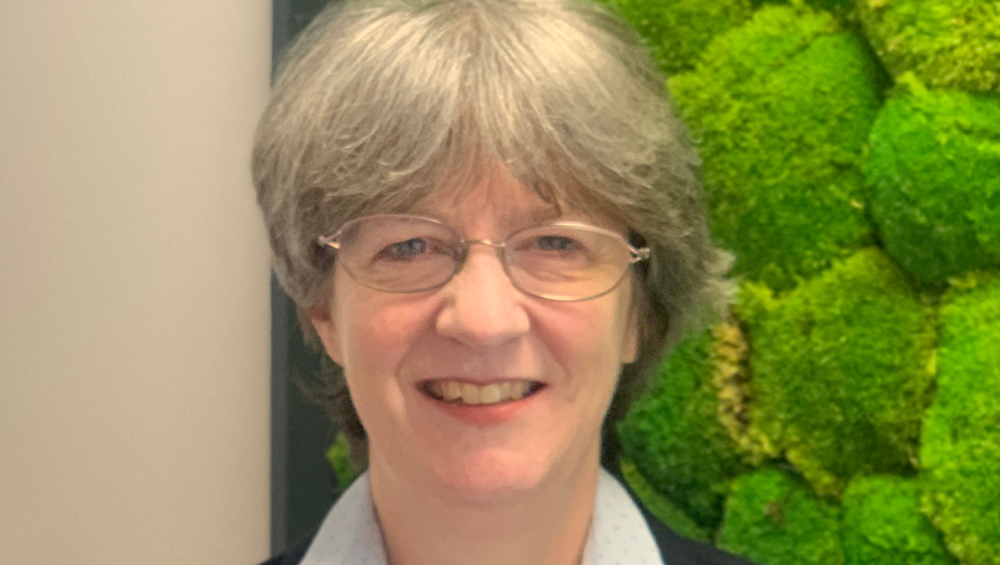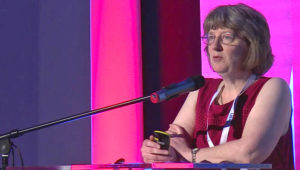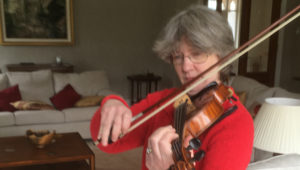
BBC’s Judy Parnall ‘A Real Force Of Nature’

After Judy Parnall fell in love with the media industry, her career focused on bringing in technology that could make a change.
Parnall was pointed to a career in broadcasting by early childhood interest in how things worked combined with her fascination in the media and the backstage work necessary to produce a show. Now the BBC’s R&D head of standards and industry, Parnall has ushered in innovations for the venerable British broadcaster, helped shape media standards across the wider industry, led technical strategy for the European Broadcasting Union’s Technical Committee and helped establish the Coalition for Content Provenance and Authentication.
She is known as a catalyst for good conversations and a diplomat who thinks several steps ahead while keeping a tight focus on audience needs. She, along with Sharri Berg, president of Fox Weather, are recipients of TVNewsCheck’s Women in Technology Leadership Award for 2022 (read Berg’s profile here) and will be honored during a reception at the NAB Show in Las Vegas on Tuesday, April 26.
“I was always fascinated by how things worked. It was never enough for me that something worked,” Parnall says. “As soon as my dad had the back off of anything, I was, ‘What’s that?’ and ‘How’s that work?’”
Her innate curiosity combined with a love of mathematics, physics and problem solving ultimately led her to study electronic engineering.
“I didn’t have pictures of pop stars in my bedroom. I had pictures of military aircraft and spacecraft. I was a geek even then,” she says.
It was a physics teacher who first suggested the BBC could be a destination for Parnall to find her life’s work.
“She said, ‘You’re really into technology and doing engineering, and you like being behind the stage, theater. Have you ever thought about going into the BBC?’” Parnall recalls.
At the time she disregarded the idea, but following a later visit to a career fair, it resurfaced, and she pursued it. She joined the BBC as a graduate of the University of Bristol with an electronic engineering background and “a fascination in all things media.”
It was, she says, “something that brings my two sides together, technical creativity and the performance side, and the backstage side as well,” she says.
When she started with the BBC in 1989, most people viewed only four or five television services, and she helped enable the technology changes that have contributed to the plethora of choices now available and taken for granted.
Just less than 20 years ago, the internet “was being used for static text and pictures, and there was a little bit of audio,” she says.
The challenge was to scale up technology, such as BBC’s resulting iPlayer, so audiences could consume audio and video content on the internet.
“This was new stuff,” she says.
Now, of course, the vast majority of content consumed via the internet is video, and standards were a critical component of the technology advances that made that possible.
Parnall has long contributed to Society of Motion Picture and Television Engineers and participated in the technical committee of the World Broadcasting Committee.
Since 2018 she has chaired the European Broadcasting Union’s Technical Committee, becoming the first woman in the organization’s history to do so. In that role she leads the technical strategy for the public service media companies from Europe and North Africa that belong to the EBU.

Parnall at the EBU’s Technical Assembly in Croatia in 2019.
With regards to chairing the EBU, she helps the more than 70 broadcasters evaluate new technology, how it can be used, what is needed to make it work, how to set those requirements and how it can be scaled.
In short, she says, “it’s all very well to have good ideas, but you need to make it work in practice.”
She seeks to work in partnership with others and to listen to other points of view. “When you’re leading and you try to solve something with your fixed ideas, you miss out.”
She prefers to consider different views to build consensus.
“I try to understand where people are coming from, especially when you’re working in cross-industry groupings like the EBU or SMTPE or any of the groups working through a standard,” Parnall says. “Understanding the needs of each of your participants and their organizations is really, really important. So, it might be someone is in a different stage of their journey” such as one in the midst of transitioning from analog to digital while another might be moving away from broadcast completely to streaming only.
Digital TV Group CEO Richard Lindsay-Davies says that Parnall’s career has often put her in a position of navigating multiple technological and political complexities simultaneously.
“Judy’s special sauce is the fact that she inspires that trust so that people will talk to her, and then she will very rationally talk about how to find a route through a problem and a route to a solution,” he says.
He worked with Parnall on the first launches of terrestrial television in the U.K. as well as Freesat (a British free-to-air satellite television service, formed in 2008 as a joint venture between the BBC and ITV). At every step of technology advancement, he says, her focus was on the audience.
“She’s brilliant at taking the audience perspective” and can “humbly step back and ask: ‘What does this really mean for the audience?’” Lindsay-Davies says. “It’s so easy to get carried away with the technology.”
Parnall is active in Project Origin — an alliance of leading tech and publishing organizations working to create a process where the provenance and technical integrity of content can be confirmed) — and was part of the team that established the Coalition for Content Provenance and Authentication (C2PA) to set the standards. She is on the steering board and works to influence regulators to incorporate the use of technology that tracks changes to media as a means of proving authenticity and tackling disinformation and deep fakes.
The goal, she says, is for the audience to be able to “make sure that what you see on the screen is actually where it came from. How do you know someone hasn’t corrupted it, changed it?”

Parnall, married with a teenaged son, plays violin for her church and remains active behind the scenes at her local community theater. She is also an avid hiker.
And from the outset, she says, she saw that for such a technology to work, it needed to be a standard that was open source and royalty free. C2PA’s first specification published earlier this year.
Now, she says, the question is how get people, along with government and regulatory authorities, to adopt the technology. Part of that is educating people on “what can the technology do, and what can the technology not do, which is also really important,” Parnall says.
Andy Parsons, senior director, Content Authenticity Initiative at Adobe, met Parnall two years ago at the outset of Project Origin.
She “is a catalyst for good conversations,” he says, and is “a real force of nature when it comes to standards.”
Parsons says Parnall brings clarity of thought and purpose to the work while also building consensus around standards creation.
“A lot of standards work involves deep dives in academic and technical topics, but Judy brings a vision of what this can be,” he says.
One such example is the C2PA specification on content binding and which file types to support the binding provenance data along with video formats to support.
“She was able to navigate those decisions in the working group and ratify it in committee,” he says.
Mounir Ibrahim, VP of public affairs and impact at Truepic, has worked with Parnall extensively through the C2PA and called her a keen observer who thinks two and three steps ahead.
“When she’s making decisions and thinking of outcomes, she’s not just thinking of the first outcome, which most people think of, she’s thinking of the second and third outcomes,” he says.
Over the 32 years of her career, passion for public service and the non-profit side of the media has driven her.
“If it works for public service, it will work for commercial as well,” she says.
And when it comes to hyping around technology, there’s a myth she’d like to bust. It’s important to know what the technology actually can do.
Sometimes the answer is “it can’t solve that thing, or it can’t solve that thing yet, which is also a really key answer,” Parnall says. “I always say for any questions that I get asked about technology is there’s yes, there’s no and there’s not yet and I think understanding where each of those fits is really important.”
Read the profiles of the other five 2022 honorees here.
In a webinar on Wednesday, April 13, this year’s Women in Technology Award winners shared thoughts on everything from multi-cloud strategies to the rise of machine learning in television workflows to how NFTs, Web3 and the metaverse may affect TV production. Watch the full video here.
































Comments (0)